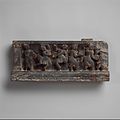Buner reliefs
| Buner reliefs | |
|---|---|
Buner |
Buner reliefs is a term for a number of stone
Most come from Buddhist contexts, but are decorative small-scale architectural sculpture, and many show purely secular scenes, in a style heavily influenced by Hellenistic art.
Hellenistic scenes
Some of the reliefs depict people in
-
Left detail
-
Centre detail
-
Right detail
Military scenes



Other reliefs, thought to be contemporary because of their identical style and structure, represent soldiers in military attire. They are depicted in ample tunics with trousers (the
Another relief is known where the same type of soldiers are dancing and playing musical instruments. The instruments are a small harp, a hand drum and a small portable xylophone. Three of the men are dancing, clasping both hands together.[1]
Buddhist scenes
Again other reliefs show people in Indian dress, typically holding lotus flowers.
All of these friezes, being contemporary with each other, hint at an intermixing of Indo-Scythians (holding military power),
These reliefs usually belonged to
One of the most famous of these reliefs is the one located in the Victoria and Albert Museum.
Other possible Buner reliefs
-
Astair riser depicting an ichthyocentaur, one of the Buner reliefs. Victoria and Albert Museum
References
- ^ Original frieze in the Cleveland Museum of Art Cleveland Museum Buner relief collection
Resources
- John Boardman, The Diffusion of Classical Art in Antiquity (Princeton University Press, 1994) ISBN 0-691-03680-2
- Alexander the Great: East-West Cultural Contacts from Greece to Japan (NHK and Tokyo National Museum, 2003)






